![]() September 2000
September 2000
By Jon C. Halter
Photographs by John R. Fulton Jr., Roger Morgan, and
Michael Roytek
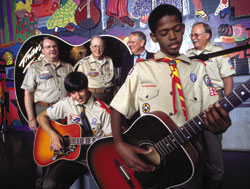 On a visit to Nashville's Country Music Hall of Fame and Museum, Russ Keasler (president, Three Rivers Council, Beaumont, Tex.), at left; Bob Purcell (executive board member, Blue Mountain Council, Kennewick, Wash.), Mack Linebaugh (president-elect, Middle Tennessee Council, Nashville), and John Katzfey (endowment chairman, Des Plaines Valley Council, LaGrange, Ill.), watch as Nashville Scouts Ryan McCoy, Troop 4, and Derek McKinney, Troop 621, try out some celebrity guitars. |
On the first day of the 2000 National Annual Meeting of the Boy Scouts of America in Nashville, a severe and dramatic evening thunderstorm rolled through middle Tennessee.
The next morning, news reports of widespread flooding and damage greeted the 2,000 Scouters and spouses at the Opryland Hotel.
For many, the storm's impact added a tone of seriousness to the BSA's 81st national annual meeting; it helped to remind those attending that, despite steady growth and the continued success of Scouting's programs, even greater challenges lay ahead for the nation in the 21st century.
At the meeting's traditional opening session, the Duty to God Breakfast, the gap between today's praiseworthy accomplishments and tomorrow's challenging goals was addressed by Dr. Joseph L. Harris, first general secretary, General Commission on United Methodist Men.
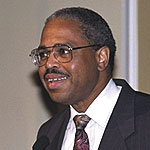 Dr. Joseph L. Harris urged churches to use the Scouting program. |
"I am proud of the United Methodist Church and what we're doing in Scouting," Dr. Harris said in noting that 11,871 Scouting units are chartered to United Methodist churches, serving 424,102 youth. "But," he added, "I have to admit we're not doing enough."
In praising Scouting for the "moral foundation that Scouters give" to youth, he urged even more churches to use the program so "the strong religious ties that Scouting has always had" will continue.
A key reason some congregations neglect to sponsor a troop and pack is their
"failure to see Scouting as a vital ministry of the church
He told of how he once arrived as a new minister at a church that had allowed
its Scouting program to dissolve, citing dwindling interest. The congregation didn't
realize that "the Scouting program did as much for the church and community as any
other ministry the church had
Churches and other faith-based institutions need to see Scouting as "not just another good program in the dozens of good programs out there, [but] as a program that will help us to reach young people in this new age."
Scouting offers churches a "tool to partner with to reach the community," Dr.
Harris said. "Every church I know has an outreach program, to encourage their young
people and adults to be involved in the community
Scouting also opens opportunities for "intergenerational ministry," allowing older adults "to work with young people in ways that they can't in other programs." Such partnerships between generations "are needed now more than ever" and "can help youth become productive citizens and more involved in the churches," he said.
Finally, Scouting as a ministry offers "moral training and discipline as a
foundational norm for its young people," Dr. Harris concluded. Programs like God
and Country—which awards religious emblems—emphasize educational and
spiritual development and service, and "go hand in hand with the goals of every
church of which I am aware," he noted. "This is why Scouting and churches are
ideal partners
To achieve Boy Scouting's highest rank, a boy must stay in Scouting long enough to complete the advancement trail to Eagle—a journey which for many begins as a 7-year-old Tiger Cub.
A multifaceted effort to increase the number of boys who complete the transition from Tiger Cubs to Cub Scouts to Boy Scouts to Venturers was a major focus of the Scouters' Luncheon.
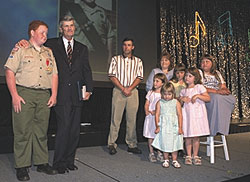 Southern Regional Director Parvin Bishop introduces Brent Reynolds and his family to a luncheon audience. The Scout from Gilmer, Tex., received an Honor Medal With Crossed Palms for heroism in saving his sister, Meagan Oller (far right), from a house fire. |
New videos for parents and unit and district leaders emphasize a seamless transition from Webelos Scouting to Boy Scouting. And they reinforce the concept of a seamless Scouting program, in which transition to the next level is a regular (and vital) step in a boy's receiving the full benefit of Scouting's leadership and character-building program.
A seminar on traditional membership gave more information on this emphasis. The gathering was one of six seminars and 16 workshops that provided Scouters with opportunities to learn more about the programs and share ideas with other volunteers.
Scouters previewed a new BSA video that provides a detailed orientation for new Cub Scout parents, especially those who are unfamiliar with Scouting's purposes, methods, and organization.
"We want to introduce 'the family of Scouting,'" explained Bill Garrison, vice
chairman of the national Cub Scout Committee. "[Parents] will bring their Tiger Cub
with the understanding that they are joining a Cub Scout pack, where they will be for
a number of years, but then they are going to graduate into Boy Scouting, and then
into Venturing
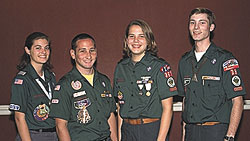 Exhibit visitors met Venturing's new national president, Kate Knuth (second from right), and regional presidents Kelly McGovern (Northeast), Daniel Brunstein (Western), and Wes Miller (Southern). |
Other seminars focused on critical issues in the BSA's National Strategic Plan 1998-2002. These included volunteer and professional leadership, endowment campaigns, operating income (Friends of Scouting campaigns), Scoutreach programs, and marketing.
In the Scoutreach seminar, Scouters heard a detailed presentation of the Chickasaw Council's innovative partnership with the University of Memphis and the Day Foundation. Scholarships are provided to local college students who agree to serve as pack and troop leaders in urban neighborhoods. The five students involved in the program's first year have made possible the creation of 10 troops and 10 packs and the participation of 550 youth. [An article on this program will appear in a future issue of Scouting.—Ed.]
Elective workshops featured topics that ranged from Venturing, Learning for Life, and Cub Scout camping to Internet technologies, risk management, and council commissioner leadership.
In the exhibit area, Scouters visited with representatives from the National Council and other sources to learn about all areas of Scouting. Displays included the latest merchandise from the Supply Division; details on Cub Scouting, Boy Scouting, Venturing, and high adventure programs; resources available from Risk Management, Health and Safety, Council Services, and Finance Support; new developments at the National Scouting Museum; and a sampling of the best of Boys' Life.
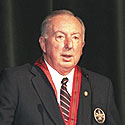 Chief Scout Executive Ratcliffe cited progress on critical issues. |
The third evening featured a special dinner honoring Chief Scout Executive Jere B. Ratcliffe, retiring after 41 years as a professional Scouter. (See "The Jere Ratcliffe years" for a summary of the achievements during Ratcliffe's tenure as Chief Scout Executive.)
At the annual business meeting the follow morning, Ratcliffe delivered his final national meeting annual report. He announced that 1999 was a "phenomenal year" and 2000 "promises more of the same," with continuing progress in the five critical issues of the 1998-2002 National Strategic Plan.
Some examples of successes in each area were presented:
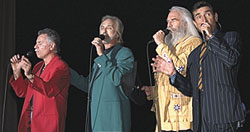 Entertainment at the closing banquet featured the Nashville sounds of the Oak Ridge Boys. |
Leadership. The Northern Lights Council, Fargo, N.D., added two unit-serving executives and several paraprofessionals to work in rural areas of the large council. This resulted in an increase in youth participation despite a declining youth population. One district had a 9.7 percent membership increase; the council added more than 200 volunteers, a 4.5 percent increase.
Total Financial Development. With a major gifts initiative that allowed donors to direct their gifts to the council's operating, capital, or endowment fund, the Orange County Council, Costa Mesa, Calif., exceeded its goal of $21 million. This enabled the council to proceed with expansion plans. These included adding 5,000 square feet to the council service center and a new camp on 140 acres of donated land.
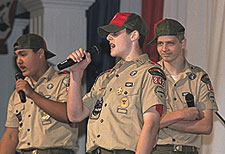 The Scout CanTeens, from Troop 842, Murfreesboro, Tenn., entertained a breakfast audience with a rousing "Responsibility Rap," based on the Scout Law. |
Marketing. The Istrouma Area Council, Baton Rouge, La., used a comprehensive plan to communicate its message though every available media outlet, helping to establish a presence in the community that impacts everything from youth and volunteer recruitment to fund-raising.
The council's membership reached 17,120 in 1999, a 26 percent increase since 1995. Friends of Scouting contributions increased 73 percent to $435,000, and United Way allocations went up 24 percent to $514,000.
Endowment Emphasis. The Housatonic Council, which serves 2,500 youth in Derby, Conn., added 16 new James E. West Fellowships to its endowment fund in 1999, using a simple, face-to-face sit-down and visit approach with potential contributors. (Nationally, more than 1,900 James E. West Fellowship endowments were established last year with contributions totaling $2,244,369.)
Total Unit and Membership Growth. Despite having its School Night for Scouting canceled by Hurricane Irene, the South Florida Council in Miami Lakes achieved a 6.5 percent growth in traditional membership. Members went directly to individual schools so they could canvass the 370,000 available youth in the council's urban and culturally diverse area, where 150 languages are spoken.
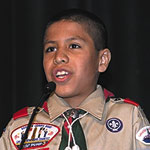 Scout Mario Castro, 12, is the 100 millionth member of the BSA. |
In the area of membership to date, the Boy Scout designated as the 100 millionth BSA member since 1910 symbolized the hope and promise of the future. Mario Castro, 12, from Troop 986, chartered to St. Michael's Catholic Church, Brooklyn, N.Y., led the meeting in a recitation of the Scout Law.
Mario's pride in his uniform and his courage in giving his presentation as he stood in front of a large room of adults offered an additional bit of inspiration for those who attended the meeting.
Scouters departed Music City U.S.A. with a renewed enthusiasm to continue and increase Scouting's impact as it fulfills its vision to serve as the nation's foremost youth program of character development and values-based leadership training.
Jon C. Halter is the editor of Scouting magazine.
|
The BSA honors adult leaders and young people for high achievement and service. Silver Buffalo Awards
Young American Awards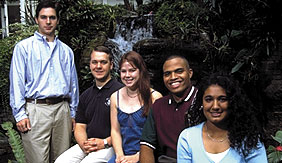 Left to right: Carl Frederick Regelmann Christopher Kirill Sokolov Alison L. Smith Julius Demarcus Jackson Svati Singla |
The 'Boy Scout at the Business School'At the National Eagle Scout Association's (NESA's) annual Americanism Breakfast, the importance of the values and ethical character expressed in the Scout Oath and Law was addressed by Dr. Kim B. Clark, recipient of the Distinguished Eagle Scout Award.
Scouting plays a major role in his life, Dr. Clark said, and when he was appointed dean of the Harvard Business School some five years ago, news media focused on that involvement. A newspaper headline dubbed him the "Boy Scout at the Business School" (although his new responsibilities forced him to reluctantly step down from his duties as a Scoutmaster). The historic missions of the Harvard Business School and the Boy Scouts of America
are similar, Dr. Clark said. The business school was founded in 1908 and the BSA in
1910, during "a time of great change in our country The business school's founders believed the emerging new institutions of business needed leaders "who were not just skilled in the practice of business, but who were also committed to strong values and to building the community and society in which they lived." And in today's turbulent world of new technologies, new enterprises, and new institutions, the school continues to educate leaders "who have the capacity to see the whole picture, to make new things emerge, and to create new things—and educate leaders who can lead and guide important enterprises in the world." But the world also needs "leaders with very strong values, who are firmly committed to a certain way of living their own personal lives, who will take that personal commitment into their work, and who will shape and influence the way in which businesses operate," Dr. Clark said. And to produce such leaders, the school needed to reaffirm "our commitment not only to our fundamental mission of education, but also to our mission of giving the world leaders with really strong values." The result was "Values in Learning," a schoolwide initiative focusing on "core values that we believe are not only essential to leadership, but essential to learning"—integrity, respect for others, and personal accountability and responsibility. "We set out to establish those values [throughout] our school," Dr. Clark explained, helping students, staff, and faculty understand and internalize them "so [the values] become a part of who they are and how they live and work." In the process, the school becomes "a living model of the highest standards of those
values," and "simply being a part of that community would be an education, a transforming
experience, from which students emerge committed to a lifetime of leadership, integrity,
and responsibility Dr. Clark expressed appreciation for the Scout leaders from his youth who taught him "what it means to be trustworthy and loyal and to do all the things that are in the Scout Law." And he also offered his thanks to the leaders of today "for what you do. It is so important."
Strong and compelling evidence of the value of quality adult leaders was offered by NESA president Robert M. Gates. He reported to the breakfast audience that 47,582 young men earned the Eagle Scout Award in 1999, a single-year record and the fourth year in a row that the total has exceeded 40,000. |
Highlights and AccomplishmentsAmong the BSA national meeting highlights were these accomplishments for 1999:
|
Milton H. Ward Is New BSA President
The BSA national annual meeting's closing banquet featured a tribute to outgoing BSA president Edward E. Whitacre Jr. and a welcome to incoming president Milton H. Ward. His two-year term as BSA national president has given him "the opportunity to meet hundreds of people who are dedicated to Scouting" and to "witness the outstanding work that Scouting does in communities across our great nation," Whitacre said. "I've seen the difference that Scouting makes
New BSA President Ward has been a member of the BSA National Executive Board since 1994, serving most recently as executive vice president. He is a past president and executive board member of the New Orleans Area Council, a member of the Denver Area Council, and a Distinguished Eagle Scout. Recently retired as chairman and president of Cyprus Amax Minerals Co., Ward is now chief executive officer of Ward Resources Inc. He has been vice chairman and director, Kinross Gold Mining Co.; vice president, Freeport Minerals Co.; president and chief operating officer, Freeport McMoRan Inc.; chairman and C.E.O., Freeport McMoRan Copper and Gold Inc.; and vice president of operations, Ranchers Exploration and Development Corp. He is a director and life member of the National Mining Hall of Fame, a board member of the Denver Art Museum, vice chairman and director of the National Museum of Natural History of the Smithsonian Institution, and a member of the National Academy of Engineering. As BSA president, his "No. 1 priority will be to continue to aggressively address the five critical issues in our Strategic Plan," Ward told the banquet audience. "We've made great strides since the plan was put together," but "much remains to be done if we are to accomplish all the objectives we have set for ourselves." In particular, Scouting's announced goal "to establish a Scouting unit in every
community in this country" is "really a daunting challenge," Ward pointed out.
"But it's a challenge which we take seriously |
| The Boy Scouts of America | http://www.scouting.org |